I’ve fasted twice a year for 3 years and find it essential to my well-being. Here’s how to do it yourself, day by day.
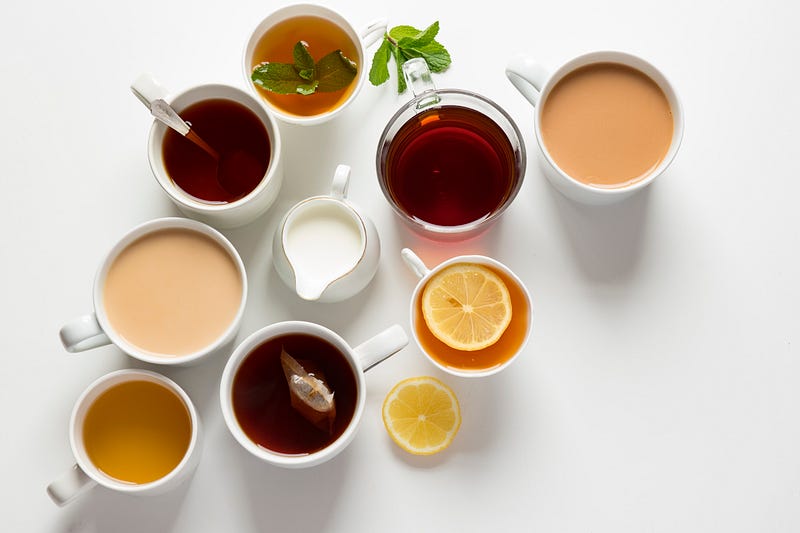
As a teenager, I thought my parents were crazy. Twice a year, they would avoid solid foods for two weeks. They survived on tea and vegetable broth.
And the weirdest thing — my parents enjoyed it.
As I grew older, judgment evolved into curiosity: why would somebody voluntarily skip food?
Fasting therapy has a long tradition in Europe. In 1917, a German doctor suffered from rheumatism. As a self-experiment, Dr. Buchinger fasted for three weeks. He cured his disease and devoted his career to fasting as a therapy.
But in May 2017, I hadn’t read a single guide on Buchinger fasting yet. I only knew what I saw from my parents. You take laxatives when you start and then consume liquids: vegetable broth, diluted fruit juice, plenty of unsweetened tea, and water.
I did my first 10-day fast, shockingly unprepared. I didn’t use an irrigator. I didn’t move and relax enough.
And yet, fasting had an incredibly positive impact.
Never before had I felt so happy and calm. I felt my body. My thoughts were clear. I felt grateful. And I improved my eating habits long after the fast.
In short: fasting had a lasting impact on my health and wellbeing. I see fasting as the most powerful natural medicine to heal the mind and body.
So, since 2017 I’ve fasted twice a year. My first four fasts were at home, my fifth in an administered fasting retreat, and the sixth during lockdown at home.
I made mistakes along the way and learned a lot during these six fasts. I read books, talked to my parents, exchanged experiences with others, and got a better fast step by step.
[Editor’s note: consult with your doctor before attempting a fast and/or taking a laxative. Especially do not embark on a fast if you are in any of the groups listed below.]
If you belong to one of the following, however, don’t do a long-term fast:
- Pregnant and breastfeeding women.
- Children.
- People with hyperthyroidism.
- People with circulatory disorders of the brain.
- People with type 1 diabetes.
- Cancer patients (due to the risk of malnutrition with permanent calorie restriction).
- People with a history of eating disorders or being underweight.
Benefits from personal experience
To give you a background of my body: I’m a 27-year-old cisgender woman with a 21 BMI. I’ve never had health complaints or operations. Before my first fast, doctors said I’m healthy.
But I wasn’t healthy. I ate a glass of Nutella a week, hated cooking, and felt addicted to eating. Plus, I didn’t like my body. I worried about gaining weight and eating too much five times every day. I felt trapped in a vicious circle of negative self-chatter.
This is how fasting changed my life:
- Food Appreciation: I started to enjoy cooking and seeing food as nourishment for my body rather than a threat.
- Healthy Diet: After fasting, I didn’t like the taste of sugar and processed foods anymore. I changed my diet, but not because I forced myself. It felt only natural to become vegan and choose fresh ingredients.
- Food Patience: I’m no longer hangry. I know my body can survive days without food, and another hour won’t hurt me.
- Body Appreciation: I felt gratitude for my healthy body and mind. What I took for granted suddenly felt special. The gratitude always remains for some months after the fasting period.
- Higher Energy Levels: I had high energy levels before my first fast. But after fasting, I’m able to tackle anything I previously avoided.
- A Clear Mind: I felt laser-sharp focus. I could look at my life from a bird’s eye perspective. I saw toxic friendships and felt the need to end them. I changed my phone habits. I decided to become self-employed. A lot of major life decisions happened as a result of my fasting experiences.
Other friends had similar experiences. Not all turned vegan and not everybody started to love their bodies. But all of them reported a greater appreciation of mind and body.
This guide is the quintessence of what I learned from my at-home fasts, the administered professional fasting retreat, and knowledge exchange with friends and my parents.
If I could, I would force my younger self to read this tutorial before her first fast.
This article will show you exactly how to create a fasting retreat in the comfort of your home.
First, you learn about the health benefits. Then you get the schedule for your fast and answers to the most common questions, like “Will I feel hungry? Will I lose muscles? Will I lose weight?” Finally, you’ll learn how to overcome the biggest hindrances along the way.
The Benefits You Can Expect From Long-Term Fasting
During fasting, two mechanisms in the body help cleanse and detox it: ketone metabolism and autophagy.
Our body focuses on sustaining our brain, and it uses glucose to do so. Sugar is in our food, and our body can produce glucose itself. That’s why we don’t die when we don’t eat sugars, like in a low-carb diet.
But at around the second day of our fast, our body has used up the glucose reserves in the blood and the liver (and converted extent muscle protein to glucose). Then, the body switches to ketone metabolism.
Ketones are a backup fuel for cells and the brain. They save our body from degrading our muscles while supplying our brains with energy. You can detect ketone increase after a few days of fasting by a slight acetone smell in the breath.
Ketones nourish the brain and can protect the brain from inflammatory cells, which play an important role in degenerative brain diseases.
During fasting, the energy normally needed for digestion, resorption, transport, and storage of nutrients, is saved—the cell switches to a protected mode, where the aging pathways are deactivated.
“Up until the mid-twentieth century, it was more or less a rule of human life that food was not available 24/7. Hard winters and unpredictable circumstances could lead to bad crop harvests. Our body adapted to this regular deficit exceedingly well in its genetic development.“
Yoshinori Ohsumi won the 2016 Nobel Prize in Medicine because he discovered somatic cells have a recycling program’ that enables them to deconstruct old, damaged, or incorrectly folded proteins into the smallest structures and then rebuild them into new, healthy complexes. This process is called autophagy and is the second mechanism that happens during fasting.
Here’s why autophagy is great for fasting, according to Dr. Michalsen, a Professor of Clinical Complementary Medicine at the Charité University Medical Centre Berlin:
“This process is initiated in instances where the cell is in distress — during fasting, for example. That’s when the cell deconstructs components that have become unnecessary in order to release energy. This energy is then used to form urgently needed molecules. About thirty-five genes control the process of this internal digestion.”
In short, autophagy is a cleanup process in the body. During fasting, the body has more capacity to concentrate on recharging the cells with nutrients that are no longer being supplied.
What science says about fasting effects
“The positive effects of fasting begin after a period of fourteen to sixteen hours. You get those positive effects whether you fast consistently every night, or maybe one entire day a week, or seven to fourteen days,” writes Prof. Dr. Andreas Michalsen.
In his 2017 book, he explains how the body cleanses and detoxes itself during a long-term fast. Let’s look at specific parts of the body. The following list of effects of fasting is the result of ketone metabolism and autophagy.
- Brain: Increases the growth factor BDNF; changes the messenger balance; enhances mood; stimulates the production of nerve cells; prevents dementia
- Liver: Stimulates production of ketone bodies and breakdown of glycogen as an alternative source of energy; leads to the reduction of the growth hormone IGF-1
- Pancreas: Decreases insulin production, recovery
- Joints: Fasting counteracts rheumatism and arthritis; relieves pain
- Cardiovascular system: Lowers blood pressure and cholesterol levels; lowers the heart rate; improves heart rate variability
- Gastrointestinal tract: Increases diversity of intestinal bacteria
- Fat tissue: Leads to fat reduction; changes to messengers (e.g., decreased production of leptin; anti-inflammatory
There are numerous scientific studies from researchers independent from Dr. Michalsen that attest to the benefits of a 10-day fast. My favorite ones include the ones that show fasting strengthens your immune system, improves your cognitive ability, enhances your mood, and alleviates major health complaints. Plus, fasting has empirically documented beneficial effects on rheumatoid arthritis, migraine, fibromyalgia, chronic pain syndromes of the locomotor system, and hypertension.
The Step-by-Step Guide to a 10-Day Fast
Long-term fasts have three phases. The first is the transition phase, where you eat low fat and high fiber. The second phase of food abstinence begins with a day for colon cleansing, followed by fasting days. After you break the fast, you enter the third phase for slow food build-up.
In the following, you’ll find the exact shopping list I always use and a guide on the three phases for your fasting schedule.
Before you start: The Shopping List
It’s nice to start with the right equipment. While doing my first fast, I wasn’t well equipped and had to go to the store every other day. It’s unnecessary self-torture to walk past a well smelling bakery store during your first fast.
With good preparation, you can easily avoid going to any grocery. Here’s what I found helpful to have at home before you start your fast:
Fasting equipment & helpful tools:
- 20 g–30 g Glauber’s salt, Bitter salt, or laxative tea for a one-time intestinal voiding.
- A running-in device (irrigator/enema) for colon cleansing during fasting.
- Massage glove or massage brush for supporting your skin’s blood flow.
- A hot-water bottle for a liver wrap (more on that later).
- Basic mineral bath salt for a full bath or foot bath.
Food for the transition phase:
- 2 l–3 l drinking water (without carbonic acid—that is to say, not sparkling/fizzy water).
- Various unsweetened herbal teas.
- Oatmeal, apples, cinnamon, rice or couscous, unsalted nuts, vegetables (e.g., broccoli, tomatoes, carrots, potatoes, eggplant).
Nutrients for 3–7 fasting days:
- 10 l –15 l drinking water (without carbonic acid).
- At least three different kinds of unsweetened herbal teas (my favorite ones include camomile, nettle, and herbal blends).
- 1 kg–2 kg vegetables for cooking a vegetable broth.
- 2 lemons.
- 1 l–2 l juice, not-from-concentrate (e.g., carrots, tomato, beetroot).
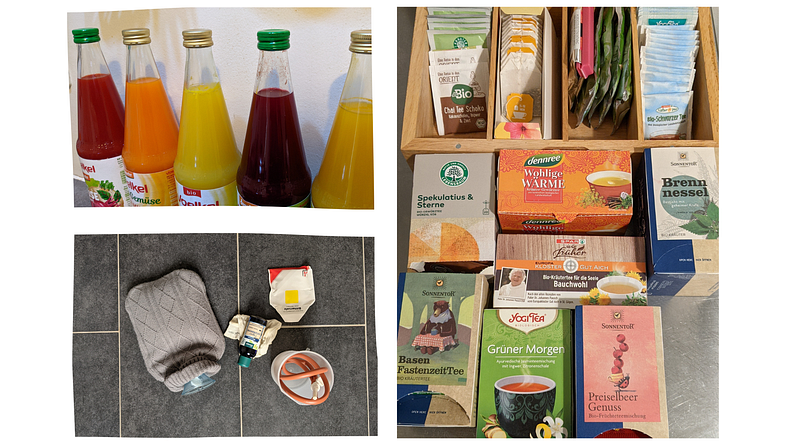
Day 1: Transition
The better the preparation, the easier the fast. In the days before fasting, you want to do anything that helps your body. This initial adjustment period with light food prepares your body and intestines slowly and gently for the transition to fasting.
The first time I fasted, I skipped the transition phase. I was like, “I should eat everything I can because I will feel so hungry during the next days.”
Hence, I ate a lot. Like a lot of lot. At least I didn’t drink alcohol, but I ate a glass of Nutella, crisps, and high-fat processed foods. Binge eating didn’t harm me but made the first days a lot more difficult.
The second time I fasted, I included a proper transition phase. Once I felt how much easier fasting was, I knew I would never skip this phase again.
Including the transition phase makes the first fasting days a lot more enjoyable.
To get the perfect start, stop eating meat, refined sugar, and processed foods. Restrain from alcohol, nicotine, and salt. Instead, drink plenty of water and unsweetened tea.
What helped me the most was a positive mindset. I avoided thinking too much about what I shouldn’t eat but focused on the recipes I would eat during the days before the fasting.
It’s a great idea to plan your meals for the transition phase. The table contains meal suggestions and supportive activities.
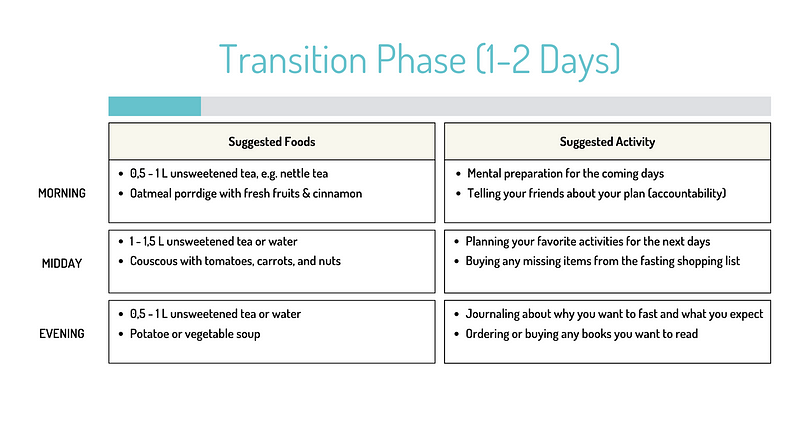
Day 2: Colon Cleansing
This day is a bit tricky because there will be a lot going on in your stomach and gut. But in my experience, once your inner organs are clean, you will feel free and light.
On the morning of this day, you start with a big cup of tea and laxatives. I personally prefer “Glauber salt” over other options such as Epsom salt or a high-dose of magnesium because it always worked really well for me.
In the retreat, most people used magnesium as it’s a bit more gentle. It worked for them as well.
Whatever laxative you choose, make sure to drink a lot of water and unsweetened tea. And keep a toilet near you for the entire day. Remember your physical hunger vanishes as soon as your stomach and digestive system are empty.
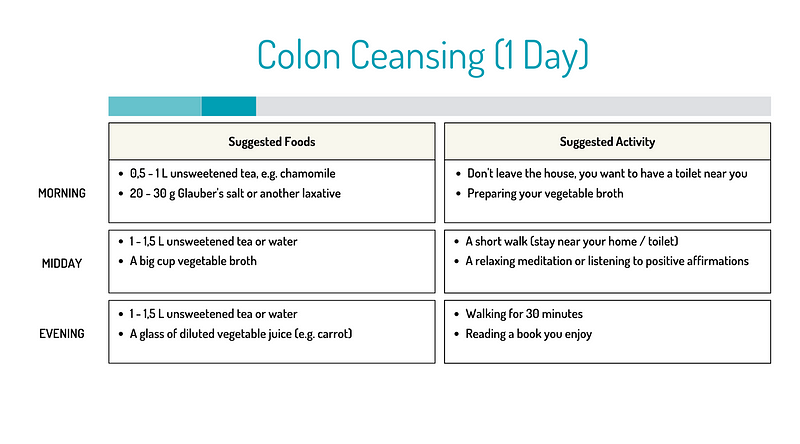
Day 3–Day 7: Fasting days with tea and broths
During the days of fasting, you skip any solid food (no macronutrients). Instead, you drink plenty of water, unsweetened tea, mineral water, and an organic vegetable broth (micronutrients).
For cooking the broth, choose your favorite vegetables, or use an existing recipe like this one or this one.
The second and third day of fast is the toughest day when it comes to energy levels. Your body changes its metabolic processes. You might feel tired, weak, hungry, and moody. But going through this day is worth it.
Many people experience a “fasting high” from day four and onwards. My experience confirms the words from Prof. Dr. Andreas Michalsen:
“From the third to fifth day, most fasting people are in a positive mood and feel satisfied, some even euphoric.”
After the first days, your mind and body feel light and free. The suggested activities aim for the right balance between exercise and relaxation. You don’t want to do sports at 100%, but keep your metabolism going by doing some lighter exercises. If you feel tired, it’s likely due to a lack of movement.
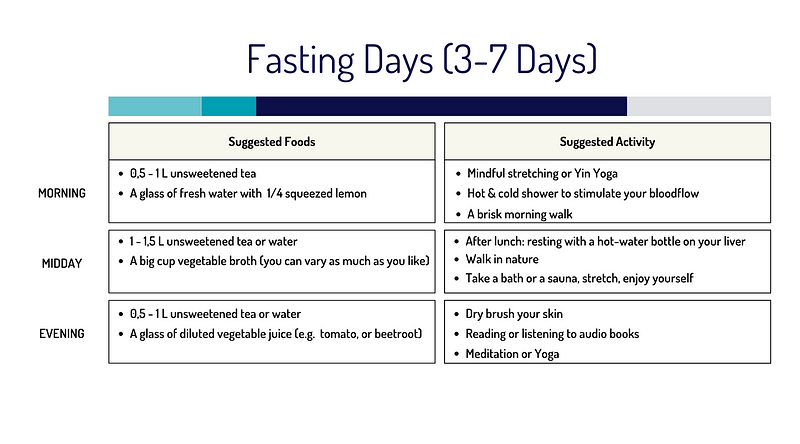
Day 8: Fast-breaking
Fast-breaking is a gradual build-up to your regular calorie intake.
On the first day of fast-breaking, you start the day by eating an apple. Eating an apple may sound unspectacular, but I promise it’ll be the best apple in your entire life.
After days of fasting, your gustatory nerves are super sensitive. You’ll have a taste sensation. So, celebrate your first solid food. Enjoy every bite and marvel at the stimulating eating experience.
It’s best to eat the apple in the morning, so your body has enough time to produce digestive juices and switch the metabolism. Just like your body needed time to ease into the fast, it now needs time to start its digestive mechanism again.
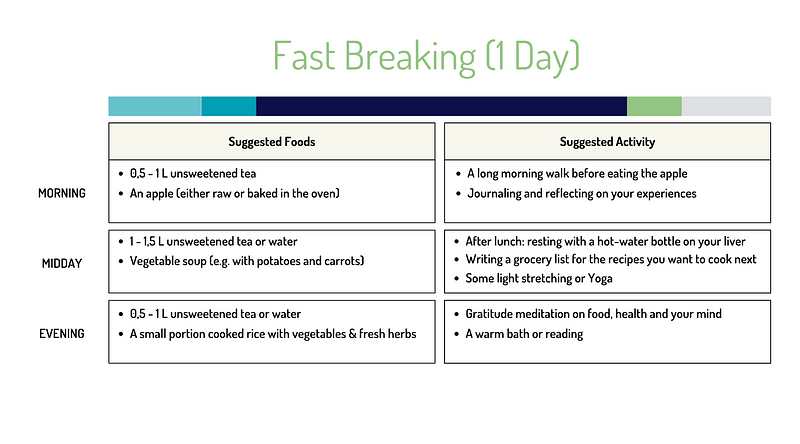
Day 9–10: Build up and reintroduction to ingesting solid foods
I know the urge to eat everything you craved for shortly after the fast break.
But resist this urge.
Give your body time to adjust.
The 2013 fasting guidelines state: “For successful fasting, a mindful and stepwise reintroduction of solid food intake is of importance and a cornerstone to successfully adopt a more healthy lifestyle following fasting.”
If you were to eat normal portion size again immediately, you would not only negate the positive effects of fasting but would actually harm yourself.
“Every fool can fast, but only a wise person knows how to break a fast.”
— George Bernard Shaw
During the build-up days, you eat easily digestible food high in fiber. The fresher, the better. The following days you proceed with a healthy whole-food diet. All ingredients should be as fresh and natural as possible.
Start with small food portions; your stomach is smaller and won’t need as much as before. Chew each bite well until there is only liquid in the mouth. Eat as slowly as you can; it might help to put the fork down after every bite. And most importantly, stop eating when you’re full.
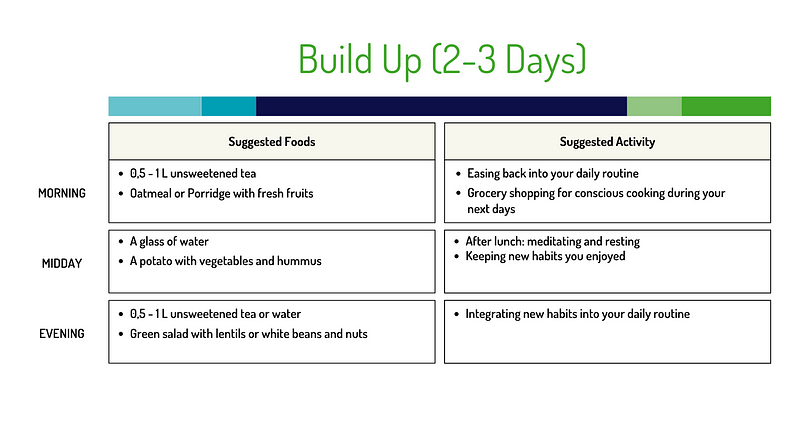
Answers to the Most Common Questions
Many people have a lot of questions before they first start. Here are the ones I always hear from friends, as well as the answers to those questions.
Will I feel hungry?
Not as much as you think. You might feel physical hunger as long as your gut is not completely empty yet. But from day two onward, you’ll unlikely feel any hunger.
A 2019 study with almost 1,500 participants showed periodic Buchinger fasting wasn’t linked to a relevant perception of hunger. On the contrary, fasting was subjectively experienced as enjoyable, which is an important factor for compliance.
Will I lose muscles?
My boyfriend does weight-lifting six times a week. He didn’t join my first three fasts as he was afraid of losing muscles. In 2019 he did some research (he’s a 5th-year medical student) and joined fasting ever since.
Here’s how he explained to me what happens to our muscles.
From a purely evolutionary point of view, it’s logical our body doesn’t lose all muscles during a fasting period. Some 4,000 years ago, our species survived by hunting and gathering. We had no refrigerators to preserve our food. So we ate most of what we found immediately.
If we’d lose muscle mass anytime we hadn’t food around us, we couldn’t survive. With less and less strength, the chance of hunting and gathering new food would decrease. So, what happens?
A little muscle mass is lost during fasting but the extent of degradation is very small. In the first fasting days, the empty gastrointestinal tract and the lack of carbohydrate causes the insulin and thus the blood sugar level to drop.
This results in higher levels of glucagon (the antagonist of insulin) and adrenaline. As a result, more fatty acids are released from fat tissue and the absorption of these into our cells (as an alternative energy supply) is simplified.
Glycogenolysis also starts — glycogen stored in the liver is released and converted into glucose, which in turn supplies us with energy. Gluconeogenesis also starts — glucose is newly synthesized from lactate, amino acids, and glycerine.
The amino acids that are used here come primarily from skeletal muscles and represent the small part in which muscles are broken down.
It’s so small because after about 14 hours the ketone metabolism, ketogenesis, gets going and is responsible for the entire energy balance after 2–4 days at the latest. Glycogenolysis and gluconeogenesis then go back to almost zero.
The substrate, i.e. the starting substance for the ketone bodies, are fatty acids, the amino acids of the muscles are no longer touched and consequently, no further muscles are lost.
Will I lose weight?
In the short-term, yes. But weight reduction is only a side effect. As Dr. Michalsen writes: “Fasting is not about reducing calories — if you simply eat less, the effect is not the same as fasting. Fasting is about using food deprivation to expose the body to small doses of stress, which leads to a stimulus reaction that detoxes the body and regulates it anew.”
Fasting can be a perfect start for changing your eating behavior. But ultimately, the kilos you lose while fasting will only stay if you manage to change into a healthy eating behavior.
Can I do fasting while working?
It depends. During those 10 days, you don’t want to have any social must attends, like weddings or birthdays. The temptation to eat makes the event unenjoyable.
You can fast while working. I fasted while I worked as a full-time teacher. I fasted while I built my startup. Here, the important thing is to do the colon cleansing while staying at home, like on the weekend.
Yet, the easiest way to fast is when you don’t have much work to do. The fewer external distractions and stress, the easier it will be for you to balance exercise and movement. It’s also easier to listen to your body.
If you have the luxury of leftover holidays, it’s a great time to use it because you can give your body all the time it needs. Home office during quarantine is actually a great time to do it, as you might be able to schedule your days more flexibly.
Is long-term fasting good for anyone?
No. Fasting is good for healthy individuals and can help treat skin diseases, rheumatism, and type 2 diabetics. But certain groups shouldn’t fast.
If you belong to one of the following, don’t do a long-term fast:
- Pregnant and breastfeeding women.
- Children.
- People with hyperthyroidism.
- People with circulatory disorders of the brain.
- People with type 1 diabetes.
- Cancer patients (due to the risk of malnutrition with permanent calorie restriction).
- People with a history of eating disorders or underweight.
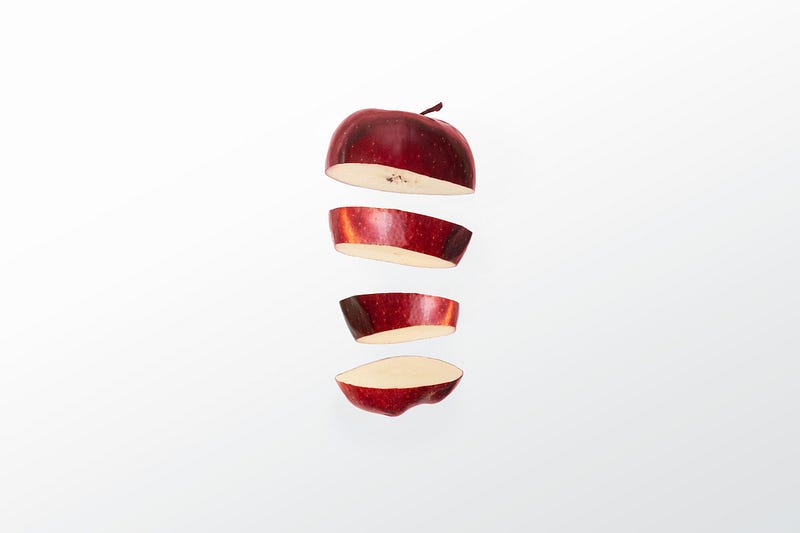
Biggest Obstacles and Tips to Overcome Them
Let’s be honest: even if you follow all of the tips and the preparation above — have all ingredients in the fridge, follow the activities, take time to be with your body — you might be tempted to break some rules or even entirely quit the fasting halfway through.
Knowing the name of these obstacles will make it easier for you to deal with each of them. The hindrances show up differently for everyone, and some don’t experience any of them.
Yet, a lot of people experience some side effects. Our bodies’ metabolic products and toxins are excreted during fasting through our detoxification organs, the intestines, liver, kidneys, and skin. Side effects like fatigue, headache, and dizziness can be natural side effects of the detoxification process.
1. Food cravings
Even if you don’t feel hungry, you might want to eat. Many people are emotional eaters and take a bite without being hungry. Anytime you smell food from a store nearby or think of food, you might experience cravings.
What to do: Start a “want-to-eat” list. Write down what you’re craving for and promise yourself to cook all these things once you’re done. By putting your desire on a sheet of paper, it’s out of your head.
2. Fatigue
You might feel a lack of energy. This might be a sign that your body wants movement. As this fasting study writes, physical activity causes a general stimulation of the macro-and microcirculation in the body, and also in excretory organs, and can enhance their activity
What to do: Move your body at 60–80% exposure. If you go running regularly, go for a light jog. If you normally jog, go for a brisk walk. Dance in your home, or do a guided yoga session.
3. Lack of concentration
Especially during the first days, focusing or sitting for a long time can be tough. You might think slower, or your comprehension isn’t that good at all. That’s why it’s a great benefit not to have a full-scheduled working week.
What to do: Be gentle with yourself. Give yourself a break and take time to rest or move. Accept that fasting can slow your brain in the short-term but know that it’ll ultimately support your body’s healing.
4. Headache
Your body and mind recover from food. When you fast, you free a lot of energy that was previously needed for digestion. You allow your body to repair and rebuild itself.
Yet, this rebuilding process also requires energy. Depending on the toxicity of your previous lifestyle (stress, processed foods, movement), the repair process will feel harder for some than for others.
What to do: If you have a headache, a large glass of water is a great first choice. Plus, using your irrigator can relieve your headache.
5. Dizziness
Especially after some time in bed, for example, in the morning, you might feel dizzy when you get up. During our last fast, my boyfriend got up so quickly in the morning that he fell back straight into his bed.
Your body’s metabolism needs more time to get going, and dizziness is a natural reaction.
What to do: You can easily prevent morning dizziness by sitting before you get out of bed. What also helps is preparing a bottle of water with some squeezed lemon, which you can drink before you leave your bed.
7. Boredom
You don’t have to go grocery shopping, cook, order food, and eat anymore. You gain one to three hours during your days, and boredom might arise. You can use this time to do something good for yourself.
What to do: If you feel bored, the first choice should be doing anything that feels good for your body. Pick your favorite activity. Go for a walk, do some yoga, journal, meditate, read, talk to friends, or sleep.
And, if you really don’t know what to do anymore, read some scientific papers on the health benefits of fasting. This is always a motivation boost.
8. Bad Taste
From day two onwards, you might experience a bad taste. Your body uses your tongue for detoxification, and bad taste is only natural.
What to do: Drink a glass of water with squeezed lemon. If you feel like it, you can also use a tongue scraper.
Are You Ready for Your Fasting Retreat?
Almost four years have passed since my ill-prepared fast in 2017. Six fasting experiences later, I truly understand why my parents stuck to this curious habit for most of their adult life.
Indeed, a liquid fast is a holistic, mind-altering, and cost-efficient way to improve your health, and thereby, your life.
However, I’d lie if I said fasting is easy and simple and like a great holiday because it isn’t. Fasting is a powerful tool that eases your body — often painful — toxins and feelings which our eating habits otherwise tend to override.
When it’s only your body without food for ten days, you’ll have not much to ease your emotions, which can be tiring, hard, annoying, and, frankly, also boring.
We’re so used to eating that our body and mind rebel like a child when we force ourselves to refrain from food intake.
But if you stick through the initial hurdles, your fasting retreat might become one of the most rewarding and grounding experiences you’ve done in life.
May your personal fasting retreat feel as rewarding and incredibly healing for you as it was — and continues to be — for me.
“Fasting is not just a physical discipline; it can be a spiritual feast.”
— Jentezen Franklin